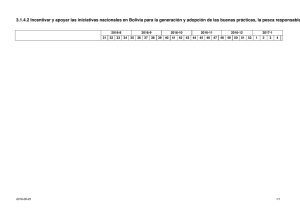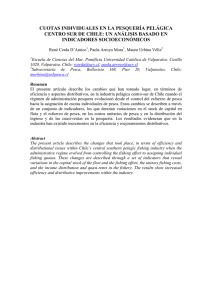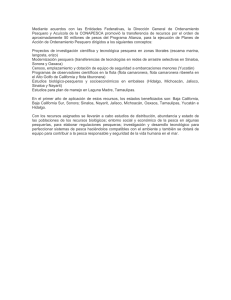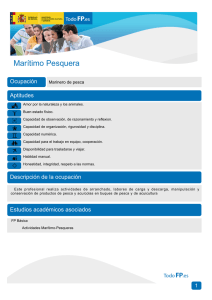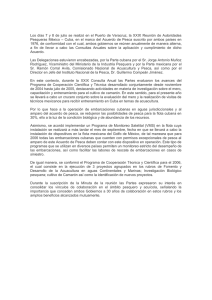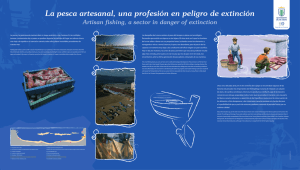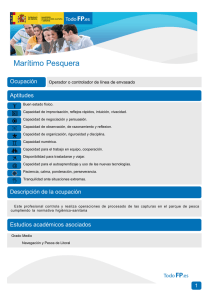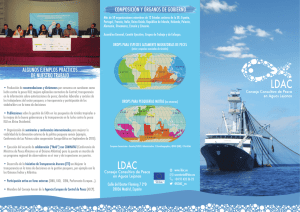Pesca Internacional, ISSN 1699-3691
Anuncio
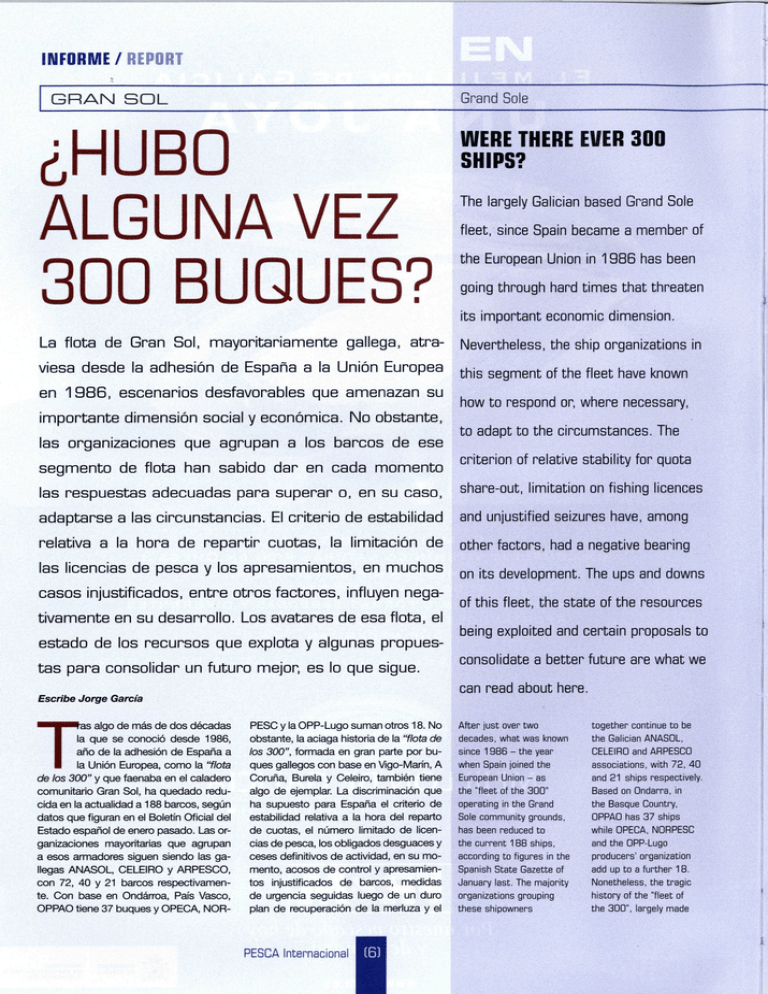
INFORME / REPORT Grand Sole GRAN SOL ¿HUBO ALGUNA VEZ 300 BUQUES? WERE THERE [VER 300 SHIPS? The largely Galician based Grand Sole fleet, since Spain became a member of the European Union in 1986 has been going through hard times that threaten its important economic dimension. La flota de Gran Sol, mayoritariamente gallega, atra- Nevertheless, the ship organizations in viesa desde la adhesión de España a la Unión Europea this segment of the fleet have known en 1986, escenarios desfavorables que amenazan su importante dimensión social y económica. No obstante, las organizaciones que agrupan a los barcos de ese segmento de flota han sabido dar en cada momento how to respond or, where necessary, to adapt to the circumstances. The criterion of relative stability for quota las respuestas adecuadas para superar o, en su caso, share-out, limitation on fishing licences adaptarse a las circunstancias. El criterio de estabilidad and unjustified seizures have, among relativa a la hora de repartir cuotas, la limitación de other factors, had a negative bearing las licencias de pesca y los apresamientos, en muchos on its development. The ups and downs casos injustificados, entre otros factores, influyen negativamente en su desarrollo. Los avatares de esa flota, el estado de los recursos que explota y algunas propuestas para consolidar un futuro mejor, es lo que sigue. being exploited and certain proposals to consolidate a better future are what we can read about here. Escribe Jorge García as algo de más de dos décadas la que se conoció desde 1986, año de la adhesión de España a Tl a Unión Europea, como la "flota de los 300" y que faenaba en el caladero comunitario Gran Sol, ha quedado reducida en la actualidad a 188 barcos, según datos que figuran en el Boletín Oficial del Estado español de enero pasado. Las organizaciones mayoritarias que agrupan a esos armadores siguen siendo las gallegas ANASOL, CELEIRO y ARPESCO, con 72, 40 y 21 barcos respectivamente. Con base en Ondárroa, País Vasco, OPPAO tiene 37 buques y OPECA, NOR- of this fleet, the state of the resources PESC y la OPP-Lugo suman otros 18. No obstante, la aciaga historia de la "flota de los 300", formada en gran parte por buques gallegos con base en Vigo-Marín, A Coruña, Burela y Celeiro, también tiene algo de ejemplar. La discriminación que ha supuesto para España el criterio de estabilidad relativa a la hora del reparto de cuotas, el número limitado de licencias de pesca, los obligados desguaces y ceses definitivos de actividad, en su momento, acosos de control y apresamientos injustificados de barcos, medidas de urgencia seguidas luego de un duro plan de recuperación de la merluza y el PESCA Internacional (6) After just over two becadas, what was known since 1986 - the year when Spain joined the European Union - as the "fleet of the 300" operating in the Grand Sole community grounds, has been reduced to the current 188 ships, according to figures in the Spanish State Gazette of January last. The majority organizations grouping these shipowners together continua to be the Galician ANASOL, CELEIRO and ARPESCO associations, with 72, 40 and 21 chips respectively. Based on Ondarra, in the Basque Country, OPPAO has 37 chips while OPECA, NORPESC and the OPP-Lugo producers' organization add up to a further 18. Nonetheless, the tragic history of the "fleet of the 300", largely made up of Galician vessels basad in Vigo-Marín, A Coruña and Burela, also has en exemplary ring to it. The discrimination that the criterion of relativa stability meant for Spain when it carne to sharing out quotas, the limited number of fishing licences, compulsory scrapping and final stoppages, at the time, seizures, emergency measures followed by a hard-hitting recovery plan ter hake and the increase in exploitation costs, among other factors, haya not prevented the organizations in this important segment of the fleet to react, in the best way possible, in the face of such a scenario, no matter how adverse it were. Prior to accession, the Spanish fleet used te catch mainly hake, monkfish, megrim and Norway lobster in Grand Sole with 460 ships. When Spain joined the European Union and depending on the share out of fishing quotas, depending en the discriminatory criterion of relative stability, this subsector saw its fishing possibilities cut back and began te go through a long restructuring process: some were able te change over to other types of fishing in other grounds. Others flagged their ships under other Member States and joined the fleets of those countries. It should be remembered that this latter option led te en adverse reaction, involving the famous British "Merchant Shipping Act, which managed te prevent ships that had obtained licences in the United Kingdom from operating for a long time. Nevertheless, the Anton D.n Sea/n.14 o 5430N Vila UNITED KINGDOM LOWYMOR CUltaid, • Portvpre ollysza Flan Vine, s:3 Vinci BA Y OF BISCA Y 4"30N o — 4'N La flota española —gallega— de Gran Sol faena regularmente en las aguas de la zona VII del CIEM durante la mayor parte del año. La división VIlj da nombre a todo el caladero: Gran Sol. En los meses de verano la flota "sube" a la zona VI —Rockall— para capturar principalmente meiga/mendo y gallo. La flota vasca faena a lo largo de casi todo el año en la zona VIII, acudiendo en los meses de verano a la VII; Algunas unidades se desplazan hasta la VI y faenan allí la mayor parte del año. The Spanish "Galician fleet operation under regulations in Grand Sole waters in ICES Zone VII for most of the year. Division VIlj gives its neme te the entire fishing grounds: Grand Sole. In the summer months, the fleet goes up%o te Zone VI" Rockall ^ mainly te catch lemon sole and megrim. The Basque fleet operates throughout almost the whole year in Zone VIII, in summer moving into VII. Some units move te VI and operate there for most ofthe year. European Court of Justice in Luxembourg finally gave its decision Fn favour of the fleet querying this measure, which forced the United Kingdom te pay out high compensation figures te the companies that had been affected. Even worse was the luck of the 112 ships that haya disappeared over the last 21 years from the socalled "fleet of the 300. Sources consultad in the incremento de los costes de explotación, entre otros factores, no han impedido a las organizaciones de este importante segmento de flota reaccionar de la mejor forma posible ante cada escenario, por desfavorable que este fuera. Antes de la adhesión, la flota española que capturaba en Gran Sol principalmente merluza, rape, gallo y cigala estaba formada por 460 buques. Con la incorporación de España a la Unión Europea y en función del reparto de cuotas pesqueras, según el discriminatorio criterio de estabilidad relativa, ese subsector vio disminuidas sus posibilidades de pesca PESCA Internacional y comenzó a experimentar una prolongada reestructuración: algunos pudieron optar por otras modalidades de pesca en otros caladeros. Otros abanderaron sus barcos en algunos Estados miembros y pasaron a ser flotas de esos países. Hay que recordar que esta última opción originó una reacción adversa, que consistió en la celebre ley británica "Merchant Shipping Act", que logró impidir durante un largo periodo faenar a los barcos que habían obtenido licencias en el Reino Unido. No obstante, el Tribunal de Justicia de Luxemburgo se pronunció finalmente a favor de la flota que cuestionó INFORME / REPORT GRAN SOL Grand Sola En las imágenes superiores, a la izquierda, un palangrero ya su lado, un arrastrero. Ambos barcos faenan en aguas de Gran Sol. esa medida, lo que obligó al Reino Unido a pagar altas indemnizaciones a las empresas que habían resultado afectadas. Más dura fue la suerte que corrieron los 112 buques que desaparecieron en estos últimos 21 años de la denominada "flota de los 300". Las fuentes sectoriales consultadas coinciden en señalar que la práctica totalidad de esos barcos optaron por las paralizaciones definitivas y fueron desguazados, con la consiguiente desaparición de algunas casas armadoras y perdida de puestos de trabajo directos e indirectos. En el caso de ANASOL, la organización asociada a la Cooperativa de Armadores de Pesca del Puerto de Vigo (ARVI), el cálculo es que en ese proceso se perdieron 16 unidades. Poder de adaptación Otros cálculos sectoriales indican que la flota española que faena actualmente en Gran Sol genera unos 1.700 empleos a directos a bordo y otros 7.000 puestos de trabajo indirectos en tierra. Las especies que se capturan —merluza, rape, gallo y cigala—, se descargan en las lonjas de Burela, Celeiro, A Coruña, Marín y Vigo. Productores, organizaciones y asesores externos trabajan en distintas alternativas para añadir valor a sus capturas, mediante procesos de selección, etiquetado y otras estrategias de comercialización. Algunos de esos proyectos ya se han materializado y otros están en etapas muy avanzadas de estudio. En el caso de ANASOL, una medida de EVOLUCIÓN DE LA FLOTA (Fleet growth) Año tYearl Buques [Vessels] 1981 1986 2005 2006 2007 460 300 199 192 188 La evolución de la flota española de Gran Sol ha resultado negativa. Aunque el ritmo de paralizaciones definitivas es significativamente más lento, en los tres últimos años se han perdido 11 unidades. (Fuente: secretaría técnica de ANASOL). The Spanish fleet in Grand Sole has grown negatively. Although the rata of final stoppages has levelled out considerably, ovar the last three years 11 units have been lost. (Source: ANASOL Technical Secretariat). pesca responsable y sostenible adoptada por la propia organización y que consistió en autolimitar las descargas de gallo pequeño en lonja, primero a 3.000 kilos por barco y marea y, desde enero pasado, a 2.500 kilos, originó una recuperación de la cotización de esa especie en primera venta en todas sus tallas. ANASOL solicitó, en su momento, la extensión de esa norma al resto de la flota española de Gran Sol que descarga en Vigo y Marín, una competencia legal que puede ejercer en función de su condi- PESCA Internacional (8) sector sil underline the fact that practically all of these ships chose to go for final stoppage and were scrapped, with the subsequent disappearance of some shipowner companies and the loas of direct and indirect jobs. In the case of ANASOL, the Grand Sole shipowner association under ARVI, estimates show that 16 units were lost in this process. Adaptability Other sector estimates indicate that the Spanish fleet currently operating in Grand 8ole generates around 1,700 direct jobs on board and a further 7,000 indirect on Iand. The species caught — hake, monkfish, megrim and Norway lobster — are landed in Burela, Celeiro, A Coruña, Marín and Vigo. Producers, organizations and external advisors work on various alternatives to add value to their catches, by selection processes, labelling and other marketing strategies. Some of these projects are already in place while others are at a very advanced study stage. In the case of ANASOL, a responsible, sustainable fishing measure adoptad by the organization itseIf, involving a self-imposed limitation on landings of small megrim in the fish market, first to 3,000 kg per ship and trip and, sinos January last, to 2,500 kg, led to a pick up in the first sale price for this species, in sil sizes. ANASOL at the time called for this measure to be extended to the rest of the Spanish fleet in Grand Sole, a legal competence of such a majority organization in this segment of the fleet. It should be noted that the dynamic action of this association and the economic dimension involved in the Grand Sola fleet focuses on making catching a profitable activity, where it only has 3.7% of the r- fishing possibilities for monkfish, 30% for hake and from 11% to 30% for megrim, depending día on the community waters zones in question. Spanish producers held out hopes, also shared by the Portuguese, that these percentages would have been increased from 2003 onwards, as provided for in the EU accession treaty for both countries. But this come to naught with the contents of the Common Fisheries Policy that consolidated the criterion of relativo stability. This fact along with the recent statements made against some of the claims tabled by Spain at the Luxembourg Court, querying the ways in which quotas are shared out, indicate a olear wish to continue with the criterion that discriminate against Spain. ANASOL Asociación de Armadores de Buques de Pesca de Gran Sol (Association of Grand Sole Shipowners] CELEIRO Puerto de Celeiro (Port of Celeiro) ARPESCO Asociación Provincial de Armadores de Buques de Pesca. A Coruña (Provincial Association of ACoruña of Fishing Vessel Owners] OPPAO Organización de Productores de Pesca de Altura de Ondárroa (Organization of Ondárroa High Seas Fish Producers) OPECA Organización de Productores de Pesca de Altura (Organization of High Seas Fish Producerd NORPESC Asociación de Medianos y Pequeños Pesqueros al Fresco Norte y Noroeste de España (Association of Small and Medium Fishing Vessels in North and Northeast Spain Freshhsh Owners) Cooperativa de Armadores de ARIA Pesca del Puerto de Vigo Organización de Productores OPP-7 Pesqueros de Lugo (Organization of Fish Producers, Lugo] ción de organización mayoritaria de ese segmento de flota. Este dinamismo asociativo y la dimensión económica que ha adquirido la flota de Gran Sol, está dirigida a tornar rentable una actividad extractiva que sólo dispone del 3,7% de las posibilidades de pesca de rape, el 30% de merluza y entre el 11% y el 30% de gallo, según las zonas de aguas comunitarias. Las esperanzas de los productores españoles, que también compartieron los portugueses, en el sentido de que estos porcentajes evolucionasen de manera positiva a partir del año 2003, tal y como estaba previsto por el tratado de adhesión a la UE de ambos países, quedaron frustradas después que los contenidos de la Política Común Pesquera consolidaran el criterio de estabilidad relativa. Esta circunstancia, unida a recientes pronunciamientos contrarios a algunos recursos presentados por España ante los tribunales de Luxemburgo, cuestionando claves de reparto de cuotas, indica una clara voluntad de mantener inalterables los criterios desfavorables a España. 4, LA MEJOR CALIDAD EN ALMACENAJE FRIGORÍFICO 03.05225084 Puesto de Inspección Fronterizo de la U.E., Depósito Aduanero, 27.000 Tm de capacidad en estanterias, carga y descargas de buques y contenedores, clasificación, paletización, picking, gestión de mercancías a través de Internet ... *CIL" Conozc 011111/FRIGALSA DESDE 1974 FRIGORÍFICOS DE GALICIA S.A. La Riouxa-Teis S/N (Ap:973) 36216 VIGO - ESPAÑA Tel: +34 986 45 88 55 Fax: +34 986 45 11 46 [email protected] INFORME / ,PORT GRAN SOL Grand Sole RENOVACIÓN, PREJUICIOS Y CUOTAS El criterio de Bruselas, acerca de que la renovación de las flotas favorece siempre una mayor capacidad de pesca, no es aplicable al caso de los buques gallegos que faenan en Gran Sol n reciente estudio realizado por ARVI analiza, entre otros U aspectos, como la flota gallega de Gran Sol comenzó a recuperar competitividad en la década de los años 90. El escenario planteado entonces era que al mismo tiempo que ese subsector extractivo se veía obligado a abordar una importante reestructuración de su número de unidades, había que hacer frente al hecho de que la edad media de sus buques era en torno a unos 30 años. Estas circunstancias debilitaban su posición respecto a sus tradicionales competidores que son, como se sabe, Francia, Irlanda y Reino Unido. La oportunidad que brindaban entonces los fondos estructurales comunitarios fue aprovechada por la flota para afrontar un dinámico proceso de renovación. ARVI ha calculado que desde 1994 hasta 2005 la inversión en nuevas construcciones de la flota gallega de Gran Sol fue de 212 millones de euros, mientras que la destinada a modernizaciones llegó a los 9,4 millones de euros. Del total de 221,4 millones de euros que resulta de sumar ambos capítulos, un 46% provino de fondos públicos y el resto correspondió a financiación privada. Este gran esfuerzo inversor y de gestión originó que Galicia disponga ahora de una flota de Gran Sol prácticamente renovada y que la edad de sus buques no supere una media de diez años de vida. El estudio mencionado también ha analizado la evolución de los TACs de las tres especies principales, merluza, rape y gallo y aunque sería precipitado sacar conclusiones definitivas, las tendencias observadas no corroboran la idea transmitida por Bruselas, acerca de que todos los recursos se encuentran cada vez peor y que la mayoría de ellos está sobreexplotado, por lo que es necesario disminuir el esfuerzo y la capacidad de pesca. Caso por caso Estas ideas, tan presentes e inspiradoras de la elaboración de la nueva Política Común de Pesca, han sido contestadas por el sector también con el argumento de que toda generalización es siempre errónea. Científicos y pescadores deben incrementar su nivel de colaboración para estudiar caso por caso. También es necesario que, como recomienda la FAO, se tengan en consideración las repercusiones sociales y económicas de las propuestas que sobre la gestión de los recursos hacen los investigadores a los centros políticos de decisión en materia de pesca. Para el sector pesquero en su conjunto, tanto la modernización como la renovación de la flota son compatibles con una explotación sostenible de los recursos, dictada desde una posición conservacionista. En las siguientes gráficas, elaboradas por ARVI, se puede apreciar como han evolucionado las cuotas de las tres especies principales que captura la flota española de Gran Sol y también comparar como inciden las cesiones e intercambios de cuotas con otros países, en los totales de las posibilidades de la pesca. Respecto a las cuotas, queda claro que no se ha producido un descenso continuado de las capturas, como se ha transmitido interesadamente desde algunos sectores de opinión. Al contrario, la tendencia es hacia una recuperación de las tres especies principales, en especial en los últimos años. También es destacable que entre 201 y 2006 la cuota de merluza creció un 77%, mientras que la de gallo entre PESCA Internacional RENEWAL, BIAS ANO ROTAS A recent study by ARVI analyzes, among other aspects, how the Galician fleet in Grand Sole began to recover competitiveness during the '90's. The scenario in place then was that, at the same time as this catching subsector was forced to cope with a substantial restructuring of the number of units, it had to deal with the fact that the average age of its ships was at around 30 years. These circumstances weakened their position in terms of their traditional competitors which are France, Ireland and the United Kingdom. The opportunity then open by the community cohesion funde was used by the fleet to deal with a vigorous renewal procese. ARVI has estimated that, from 1994 to 2005, investment in newbuilds in the Galician Grand Sola fleet was 211,950,000 euros, while modernization investments amounted to 9,360,000 euros. Out of the total of 221,310,000 euros arrived at by adding both chapters, 46% came from public funde and the rest from private funding. This considerable investment and management effort led Galicia to the current situation where it has a practically renewed Grand Sole fleet, where the average age of its ships does not exceed ten years. This study also analyses the development of the TACs for the three main species: hake, monkfish and megrim. Although it would be hasty to reach final conclusions, the trends observed do not corroborate the idea conveyed by Brussels in that sil the resources are increasingly worse and that the majority of them are overexploited, thus the need to reduce fishing effort and capacity. Case by case These ideas, which inspired the drafting of the new Common Fisheries Policy, have been contested by the sector with the argument that any generalization is a crass error. Scientists and fishermen should increase the extent of their collaboration in order to study this on a case by case basis. There is aleo a need, as recommended by the FAO, to take into consideration the social and economic repercussions of the proposals made by researchers to the central policy makers on fishing. For the fishing sector as a whole, both the modernization and renewal of the fleet are compatible with a sustainable exploitation of the resources, from a conservationist point of view. The following graphs, drawn up by ARVI, show how the quotas for the three main species have developed for the Spanish Grand Sole fleet. A comparison can be made of how quota exchanges with other countries have en effect on the totals of catch possibilities. As regards quotas, clearly there has not been a continued fall in catches, as has been conveyed, to protect their own interests, by come sectors of opinion. On the contrary, the trend is towards a recovery of the three main species, especially over the last few years. It is aleo to be noted that from 2001 to 2006, the hake quota was increased by 77%, whereas the megrim quota from 2002 to 2006 was increased by 29%. Lastly, monkfish quota increased, from 2003 to 2006, by 14 000 — 12.850 Merluza (Hake) 12 000 — 11.060 10,640 10 880 11.585 11 080 11.420 9.950 u) 9.190 CD Cll 9.940 9.770 9.940 1 O 000 — 8.000— Historic development of fish quotas Zones Vb (a.CE), VI, VII, XII, XIV 6 000— Evolución histórica de las cuotas de pesca Zonas Vb (a.CE), VI, VII, XII, XIV 4.000— Evolución de las posibilidades de pesca totales de España (incluidas las cesiones de otros Estados miembros) Zonas Vb (a.CE), VI, VII, XII, XIV Development of total fishing possibilities for Spain (including exchanges with other Member States). Zones Vb (a.CE), VI, VII, XII, XIV 2 000 1 I I 1 1 1 1 I I 11 1 I I 1 1 1 1986 1987 1988 1989 1990 1991 1992 1993 1994 1995 1996 1997 1998 1999 2000 2001 2002 2003 2004 2005 2006 Años Cómo poner en marcha tu iniciativa sin que se hunda tu idea... ...entra en P esc@p 1 u s ''ración oficina ora la de proyectos de innovación tecnológica Pesc@plus es la Oficina de Promoción y Dinamización de Proyectos de I+D+i del sector pesquero y acuícola. Te ofrecemos información, apoyo y asesoramiento gratuito a través de una red de oficinas, agentes tecnológicos y el portal www.pescaplus.es Diagnós Pescaplus. Eldentifica de ayudas, iSolicitud das. Entra ya e infórmate. BOO 902 104 580 • www.pescaplus.es WW,I4V"' ICKV"" ' Ernn '<=cZros S INFORME / "r" GRAN SOL 3 500 Grand Sola Historic development of fish quotas Zones Vb (a.CE), VI, VII, XII, XIV 3.000 2.500 - CD 2.000 2.953 Evolución histórica de las cuotas de pesca Zonas Vb (a.CE), VI, VII, XII, XIV Rape (Monkfish) Evolución de las posibilidades de pesca totales de España (incluidas las cesiones de otros Estados miembros) Zonas Vb (a.CE), VI, VII, XII, XIV Development of total fishing possibilities for Spain (including exchanges with other Member States). Zones Vb (a.CEJ, VI, VII, XII, XIV - CO CO CO ditt - - o 2 163 1.540 1.540 1.540 1.540 1.540 1.477 1 500 - 1.310 1.310 1.310 1.200 1.150 1.151 1.010 1 000 _ 1.040 990 703 500 1 1 I 1 I 1 1 1 1 1 1 1 1 1 1 1 1986 1987 1988 1989 1990 1991 1992 1993 1994 1995 1996 1997 1998 1999 2000 2001 2002 2003 2004 2005 2006 Años 9 000 - 8.000 - 7.820 7.599 Gallo (Megrin) 7.431 7.270 7.2707.270 1,10 •••• ida 7.000 6.550 UD CO TD CO CD o o 6.535 6.250 5.310 1••• 5 000- 3.000 4.830 5.950 5.310 5.310 5.310 7/•nn MI. 5.817 5.930 5.839 Mal 5.310 4.830 .../. - 4 000- 6.106 6.250 6.000- Historic development of fish quotas III 1111 Zones Vb (a.CE), VI, VII, XII, XIV Evolución histórica de las cuotas de pesca Zonas Vb (a.CE), VI, VII, XII, XIV 4.796 5.000 4.500 Development of total fishing possibilities Evolución de las posibilidades de pesca totales de España for Spain (including exchanges with other (incluidas las cesiones de otros Estados miembros) Member States). Zones Vb VI, Zonas Vb (a.CEI, VI, VII, XII, XIV I I I I I I I VII, XII, XIV I I I I I I I I I 1986 1987 1988 1989 1990 1991 1992 1993 1994 1995 1996 1997 1998 1999 2000 2001 2002 2003 2004 2005 2006 Años PESCA Internacional I 64%. These figures show that the axiom coming from the community politicians in charge that "the renewed fleets are seriously damaging stock sustainability" does not, in this case, ring true. Nevertheless, everybody knows that the quotas assigned te Spain are still low, a fact that is corrected by exchanges among Member States. This mechanism, although efficient in practice, te keep the Grand Sale fleet viable, leads te a political dependency as well as te instability. This latter aspect is clearly notad in the "saw tooth" graphs shown year after year in some cases. PROPOSALS FOR THE FUTURE OF THE SECTOR any that are considered te be The expectations of the Spanish fleet operating in Grand Sole more appropriate should be community waters lb in being studied and analyzed in order te able te continue with the upward guarantee the sustainability of trend in fishing quotas for the the resources. 5. The Grand Sola fleet should three main species, as shown by the graphs en these pagas be studied from a socioillustrating the historie groWch of economic point of view, in order quotas. It is also necessary for the te determine the impact of the exchanges of fishing possibilities management measures. 6. Any company voluntarily te be covered by efficient policies applied by the Administration. The opting for scrapping vessels should be given priority attention investment effort made over the in terms of the structural funds. last twelve years, to be able te This mechanism will optimize the haya a competitiva fleet, should not and can not be interfered with accumulation of fishing rights in by uncertainties. A brief rundown that particular fleet. 7. Technological innovations in of the proposals in the various the fleet should have a salid studies carried out by ANASOL and ARVI is as follows: financial backing in order te cut down exploitation costs, 1. Relations between scientists and sector need te be closer and particularly those arising from more productiva, among other the constant increase in fuel reasons, te be able te develop cost. a fisheries research en the 8. The quality and marketing of fisheries products should resources with more means and possibilities. be given ongoing attention. 2. Scrapping should be the The sector and likewise the ultimate solution te take. In arder administrations should work in a coordinated manner te draw up te ensure sustainable fishing, temporary stoppages, catch limits measures aimed at improving per fishing trip and per ship as both aspects. well as other measures of this 9. Regional 'Tríple Propeller" economic boosting strategies sort should suffice. [involving administration, 3. The sector considers that a revision of the exploitation models scientists and the sector] have is healthy where it ent,ails analyzing proven te be efficient and are implementing transferable applicable te this segment of fishing rights fITQ's) as a whole the fleet. 10.The varees organizations for certain segments of the community fleet. The principies grouped under the Grand Sole underpinning the current Common fleet have sector interests that Fisheries Policy should be taken te coincide with each other. This provides a good opportunity te be unmovable. work together. 4. As regards fishing methods, 2002 y 2006, se incrementó en un 29%. Finalmente la de rape subió, entre 2003 y 2006 un 64%. Estas cifras demuestran que el axioma de los responsables políticos comunitarios, acerca de que "las flotas renovadas perjudican gravemente la sostenibilidad de los stocks", no se corresponde en este caso con la realidad. No obstante, todo el mundo sabe que las cuotas asignadas a España si- guen siendo escasas, un hecho que se corrige mediante cesiones e intercambios con otros Estados miembros. Ese mecanismo, aunque eficaz en la práctica para mantener la viabilidad de la flota de Gran Sol, genera dependencia política además de inestabilidad. Este último aspecto se aprecia claramente en los "dientes de sierra" que se pueden observar de un año para otro en algunos casos. PROPUESTAS PARA EL FUTURO DEL SECTOR as expectativas de la flota española que faena en las aguas coL munitarias de Gran Sol son en el sentido de que se mantenga la tendencia al crecimiento que experimentan las cuotas pesqueras de las tres especies principales, según revelan las gráficas de estas páginas dedicadas a la evolución histórica de cuotas. También es necesario que las cesiones e intercambios de las posibilidades de pesca sean objeto de políticas eficaces por parte de la Administración. El esfuerzo inversor de los últimos doce años, para disponer de una flota competitiva, no debe ni puede estar mediatizado por incertidumbres. Una síntesis de las propuestas de los distintos estudios que han realizado ANASOL y ARVI es lo que sigue. 1.- La relación entre científicos y sector debe ser más estrecha y productiva para, entre otras cosas, desarrollar una investigación pesquera sobre los recursos con más medios y posibilidades. 2.- Los desguaces son la última de las soluciones. Para asegurar una pesca sostenible, las paralizaciones temporales, los topes de capturas por marea y barco y otras medidas de ese tipo deberían ser suficientes. 3.- El sector valora como saludable la revisión de los modelos de explotación que supone analizar en conjunto la implantación de los derechos transferibles de pesca (ITQs), para determinados segmentos de flota del ámbito comunitario. Los criterios que sustentan la actual Política Común de Pesca no deben PESCA Internacional considerarse inamovibles. 4.- En materia de artes de pesca, deben estudiarse y analizarse aquellas que resulten más convenientes para garantizar la sostenibilidad de los recursos. 5.- La flota de Gran Sol debe ser objeto de estudios socioeconómicos, para conocer el impacto de las medidas de gestión. 6.- Las empresas que voluntariamente opten por desguazar sus buques, deben tener una atención prioritaria por parte de los fondos estructurales. Este mecanismo optimizará la acumulación de derechos de pesca en esta flota. 7.- Las innovaciones tecnológicas destinadas a la flota deben tener un respaldo financiero sólido para reducir los costes de explotación, en particular los derivados del constante incremento del coste del combustible. 8.- La calidad y comercialización de los productos pesqueros deben ser objeto de atención permanente. El sector y también las administraciones deben trabajar en forma coordinada en la elaboración de medidas dirigidas a mejorar ambos aspectos. 9.- Las estrategias de dinamización económica regional de "Triple Hélice" (administración, científicos y sector), se han demostrado eficaces y son de aplicación para este segmento de flota. 10.- Las distintas organizaciones que agrupan a la flota de Gran Sol tienen intereses sectoriales coincidentes. Esto representa una buena oportunidad para trabajar puntualmente en conjunto.
